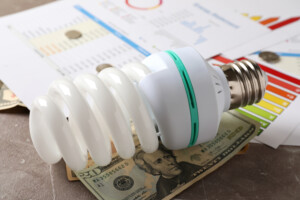
In response to rising energy costs, many Americans are looking for ways to conserve electricity. But because there are so many household appliances we rely on for comfort and safety, lowering utility bills is not always a straightforward process. But small changes can can make a big difference. From simple habits to home upgrades, here are five simple energy saving tips you can use to minimize power consumption.
Shut Off Electrical Devices
Everyone knows to turn off the lights when they leave the room. However, some devices don’t power down when you switch them off. Tablets, smartphones, game consoles, computers, and televisions draw electricity even when you’re not using them. This is an in-built feature known as “standby mode.” It allows devices to reactivate faster and download updates automatically while you’re not using them.
Unfortunately, it also means some devices run twenty-four hours a day. According to some manufacturers, standby mode accounts for around 40 percent of total energy use. For large devices, installing a smart power strip is the best solution. They automatically cut electricity to devices when they’re inactive. Smaller devices can be simply unplugged once they’re fully charged.
Buy Better Light Bulbs
Replacing incandescent lights with LED (Light Emitting Diodes) bulbs cuts lighting costs by as much as 75 percent. LEDs are also less expensive and last ten times longer than incandescent light bulbs, reducing expenses even further. Modern LEDs are suitable for every type of application, including Christmas lights. They work especially well with dimmers, for even greater control over home energy use.
Run Full Loads
Dryers, dishwashers, and washing machines are three of the most energy intensive appliances in your house. In fact, drying your clothes consumes more electricity than your refrigerator, washing machine, and dishwasher combined! Running full loads ensures you get the most out of every cycle, reducing the amount of energy you need to clean your plates, clothes, and utensils.
To maximize energy efficiency, switch from hot water to cold water when doing laundry. Heating water is incredibly costly and, contrary to what you may think, cold water is just as good at removing stains. Clean your dryer filter after every use as well. Strong air flow reduces drying times and heating costs.
Turn Down Your Thermostat
Most households spend half their energy budget on heating and cooling. Besides replacing out-of-date units with modern, ENERGY STAR systems, adjusting your thermostat is the fastest way to lower HVAC costs. Raising or lowering it even a few degrees can save up to ten percent.
Remember that you don’t need to warm or cool your home entirely. Just to the point you feel comfortable in seasonal clothing. Purchasing a smart thermostat helps further optimize HVAC performance. Its digital interface lets you manage heating and cooling schedules remotely, through your smartphone, in order to prevent unnecessary energy consumption.
Seal Air Leaks
Drafts may not seem like a big deal, but in most homes, they’re the leading source of energy loss. By some estimates, up to 30 percent of your heat and air conditioning escapes through gaps around doors and window frames, caused by thermal expansion or as your home foundation settles. Sealing them reduces the number of heating and cooling cycles required to maintain your desired temperature.
While some people hire a handyman, most homeowners can tackle the problem on their own. Most drafts can be detected by hand, but if you’re uncertain, try the flame test. Hold a candle near the door or window and watch the flame. If it flickers, you’ve probably got a gap. An incense stick works as well. Light it and see whether the smoke is blown to the side or drifts upwards. Repeat the process on every door and window in your home. When you find a gap, fill it in with a little caulk.
Saving on Home Energy Repairs with Agway
Changing your habits is the best way to conserve energy, but it doesn’t relieve the strain on your furnace and air conditioner. These systems run practically non-stop six months out of the year, leading to operational strain. Insurance doesn’t cover this type of damage, but Agway does. Our EnergyGuard™ Program protects your heating, cooling, and internal wiring from problems caused by daily use.
What’s more, when the need for repair occurs, our customers don’t waste time searching for a qualified repairman. They call us instead. Our service team maintains a network of certified contractors and electricians in your area, ready to respond to emergencies. There is no need to worry about service fees or deductibles either. We pay for the visit and all covered parts. Don’t let a breakdown strain your budget. Sign up and start enjoying the benefits of EnergyGuard™ today!